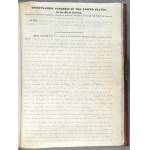Indian Removal Act
5/28/1830
Add to Favorites:
Add all page(s) of this document to activity:

Add only page 1 to activity:
Add only page 2 to activity:
In the early 1800s, American demand for Indian nations’ land increased, and momentum grew to force American Indians further west. The first major step to relocate American Indians came when Congress passed, and President Andrew Jackson signed, this Act on May 28, 1830.
It authorized the President to negotiate removal treaties with Indian tribes living east of the Mississippi River. The goal was to remove all Native Americans living in existing states and territories and send them to unsettled land in the west.
On December 6, 1830, in his annual message to Congress, President Andrew Jackson informed Congress on the progress of the removal, stating, “It gives me pleasure to announce to Congress that the benevolent policy of the Government, steadily pursued for nearly thirty years, in relation to the removal of the Indians beyond the white settlements is approaching to a happy consummation.”
By the end of Jackson’s Presidency, his administration had negotiated almost 70 removal treaties. These led to the relocation of nearly 50,000 eastern Indians to the Indian Territory—what later became eastern Oklahoma. It opened up 25 million acres of eastern land to white settlement and, since the bulk of the land was in the American south, to the expansion of slavery.
Perhaps the most well-known treaty, the Treaty of New Echota, ratified in 1836, called for the removal of the Cherokees living in Georgia, North Carolina, Tennessee, and Alabama. The treaty was opposed by many members of the Cherokee Nation, and when they refused to leave, Maj. Gen. Winfield Scott was ordered to push them out. He was given 3,000 troops and the authority to raise additional state militia and volunteer troops to force removal.
Despite Scott’s order calling for the removal of Indians in a humane fashion, this did not happen. During the fall and winter of 1838-39, the Cherokees were forcibly moved from their homes to the Indian Territory—some having to walk as many as 1,000 miles over a four-month period. Approximately 4,000 of 16,000 Cherokees died along the way. This sad chapter in our history is known as the “Trail of Tears.”
By the 1840s, nearly all Indian tribes had been driven west, which is exactly what the act intended to accomplish.
It authorized the President to negotiate removal treaties with Indian tribes living east of the Mississippi River. The goal was to remove all Native Americans living in existing states and territories and send them to unsettled land in the west.
On December 6, 1830, in his annual message to Congress, President Andrew Jackson informed Congress on the progress of the removal, stating, “It gives me pleasure to announce to Congress that the benevolent policy of the Government, steadily pursued for nearly thirty years, in relation to the removal of the Indians beyond the white settlements is approaching to a happy consummation.”
By the end of Jackson’s Presidency, his administration had negotiated almost 70 removal treaties. These led to the relocation of nearly 50,000 eastern Indians to the Indian Territory—what later became eastern Oklahoma. It opened up 25 million acres of eastern land to white settlement and, since the bulk of the land was in the American south, to the expansion of slavery.
Perhaps the most well-known treaty, the Treaty of New Echota, ratified in 1836, called for the removal of the Cherokees living in Georgia, North Carolina, Tennessee, and Alabama. The treaty was opposed by many members of the Cherokee Nation, and when they refused to leave, Maj. Gen. Winfield Scott was ordered to push them out. He was given 3,000 troops and the authority to raise additional state militia and volunteer troops to force removal.
Despite Scott’s order calling for the removal of Indians in a humane fashion, this did not happen. During the fall and winter of 1838-39, the Cherokees were forcibly moved from their homes to the Indian Territory—some having to walk as many as 1,000 miles over a four-month period. Approximately 4,000 of 16,000 Cherokees died along the way. This sad chapter in our history is known as the “Trail of Tears.”
By the 1840s, nearly all Indian tribes had been driven west, which is exactly what the act intended to accomplish.
Transcript
Twenty-First Congress of the United States; At the First SessionBegun and held at the City of Washington, on Monday, the seventh day of December, one thousand eight hundred and twenty-nine.
An Act to provide for an exchange of lands with the Indians residing in any of the States or Territories, and for their removal West of the river Mississippi.
Be it enacted by the Senate and House of Representatives of the United States of America, in Congress assembled, That it shall and may be lawful for the President of the United States to cause so much of any territory belonging to the United States, west of the river Mississippi, not included in any state or organized territory, and to which the Indian title has been extinguished, as he may judge necessary, to be divided into a suitable number of districts, for the reception of such tribes or nations of Indians as may choose to exchange the lands where they now reside, and remove there; and to cause each of said districts to be so described by natural or artificial marks, as to be easily distinguished from every other. Section 2. And be it further enacted, That it shall and may be lawful for the President to exchange any or all of such districts, so to be laid off and described, with any tribe or nation of Indians now residing within the limits of any of the states or territories, and with which the United States have existing treaties, for the whole or any part or portion of the territory claimed and occupied by such tribe or nation, within the bounds of any one or more of the states or territories, where the land claimed and occupied by the Indians, is owned by the United States, or the United States are bound to the state within which it lies to extinguish the Indian claim thereto. Section 3. And be it further enacted, That in the making of any such exchange or exchanges, it shall and may be lawful for the President solemnly to assure the tribe or nation with which the exchange is made, that the United States will forever secure and guaranty to them, and their heirs or successors, the country so exchanged with them; and if they prefer it, that the United States will cause a patent or grant to be made and executed to them for the same: Provided always, That such lands shall revert to the United States, if the Indians become extinct, or abandon the same. Section 4. And be it further enacted, That if, upon any of the lands now occupied by the Indians, and to be exchanged for, there should be such improvements as add value to the land claimed by any individual or individuals of such tribes or nations, it shall and may be lawful for the President to cause such value to be ascertained by appraisement or otherwise, and to cause such ascertained value to be paid to the person or persons rightfully claiming such improvements. And upon the payment of such valuation, the
improvements so valued and paid for, shall pass to the United States, and possession shall not afterwards be permitted to any of the same tribe. Section 5. And be it further enacted, That upon the making of any such exchange as is contemplated by this act, it shall and may be lawful for the President to cause such aid and assistance to be furnished to the emigrants as may be necessary and proper to enable them to remove to, and settle in, the country for which they may have exchanged; and also, to give them such aid and assistance as may be necessary for their support and subsistence for the first year after their removal. Section 6. And be it further enacted, That it shall and may be lawful for the President to cause such tribe or nation to be protected, at their new residence, against all interruption or disturbance from any other tribe or nation of Indians, or from any otherperson or persons whatever. Section 7. And be it further enacted, That it shall and may be lawful for the President to have the same superintendence and care over any tribe or nation in the country to which they may remove, as contemplated by this act, that he is now authorized to have over them at their present places of residence: Provided, That nothing in this act contained shall be construed as authorizing or directing the violation of any existing treaty between the United States and any of the Indian tribes. Section 8. And be it further enacted, That for the purpose of giving effect to the provisions of this act, the sum of five hundred thousand dollars is hereby appropriated, to be paid out of any money in the treasury, not otherwise appropriated.
[signature] A. Stevenson, Speaker of the House of Representatives
[signature] J.C. Calhoun, Vice President of the United States and President of the Senate
approved May 28th 1830
[signature] Andrew Jackson
I certify that this act did originate in the Senate.
Walter Lowrie, Secretary.
This primary source comes from the General Records of the United States Government.
Full Citation: Indian Removal Act; 5/28/1830; Enrolled Acts and Resolutions of Congress, 1789 - 2011; General Records of the United States Government, Record Group 11; National Archives Building, Washington, DC. [Online Version, https://docsteach.org/documents/document/indian-removal-act, April 26, 2024]Rights: Public Domain, Free of Known Copyright Restrictions. Learn more on our privacy and legal page.





